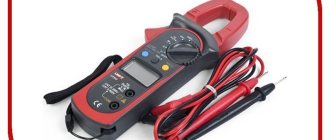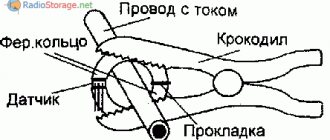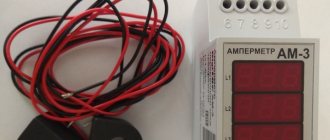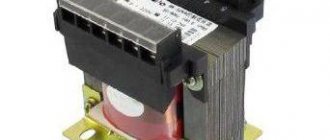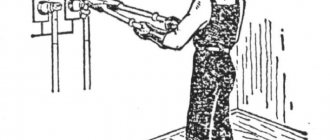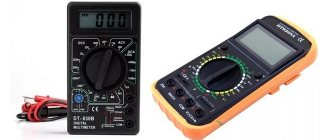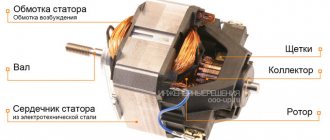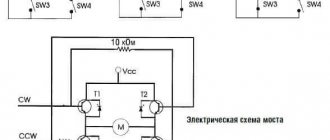Current clamp design
Most current clamps consist of the following elements:
- Detachable spring-loaded magnetic circuit;
- Magnetic circuit opening button;
- Switch for the measurement circuit, that is, the current range;
- Display screen;
- 2-3 sockets for connecting probes;
- Handle for holding the tool;
- Memory buttons.
Types of current clamps
A large variety of clamp options for measuring current have been invented.
The most common devices include:
- Devices with a pointer analyzer. They can react to even the smallest vibrations.
- Digital models. Devices with a monitoring system for data processing.
- High voltage products. Used for work under high voltage.
Distinctive features
Digital clamps with a multimeter - used to measure current without disturbing the connection and external insulation of conductors on cables from single-phase and three-phase systems.
A large number of measuring clamps can operate with alternating currents and are designed to operate using a transformer circuit.
However, you can purchase clamps to detect direct current, based on a Hall sensor, which generates an electrical signal when influenced by the level of the magnetic field that envelops the wire with direct current.
- You can use automatic clamp meters for measuring current for home needs, and they can also be produced along with the useful functionality of a multimeter.
- Many automotive electricians use professional multimeters and current clamps to diagnose vehicles.
Buying a car current clamp with a multimeter for diagnosing vehicles will be an excellent choice in price and quality, due to this ratio, current measuring devices will be excellent assistants in the relevant areas.
Device parameters and measurement progress
There are several ways to measure. You can detect the current flowing through a conductor that is placed in a clamp at a right angle. The indicator will show the desired range. The second method is suitable for measuring current passing through several conductors. The latter (uncommon method) amplifies signals.
The size of the conductor to be measured is limited using a handle. The process goes like this: the pliers move apart, a wire is passed through, the handle is released and the pliers are closed. The subsequent steps are similar to using a simple tester. The insulation of the electrical wire does not matter. It is important to cover only the tire.
This device is easy to measure in hard-to-reach places
The digital or mechanical indicator will show the current value. Some devices can record results for convenience. The value remains after the magnetic circuit is separated from the conductor.
The ammeter measures the current flowing through the secondary winding through the occurrence of electromagnetic induction.
Application benefits
The advantages of current measuring clamps include:
- Ability to measure electric current without disconnecting the circuit;
- Small device dimensions;
- Ease of measurement in high-voltage circuits.
Thanks to current clamps, it is also possible to record very high currents. Before purchasing this electrical device, you need to carefully familiarize yourself with its characteristics.
It is better not to save on tools, but to purchase only high-quality devices, based not on cost, but on the popularity of the brand.
Selection by function
When choosing clamps for measuring current, you should take a closer look at individual functions that have proven useful in using the device in specific circumstances.
We provide information about these opportunities:
- We need to embrace the purpose of True RMS. Devices measuring alternating current, where this was not possible, produce figures for circumstances where the current has a sinusoidal shape. Just three decades ago, owners had few types of electrical equipment, because the current in the electrical network had a sinusoidal shape. Nobody considered it important that deviation from the parameter would affect the measurement data. Nowadays, when light bulbs with LEDs and energy-saving capabilities are used, as well as switching-type power supplies, the shape of the current in the electrical network is not ideal. Clamp meters are used when accidents occur, which are often explained by a large deviation of the current from the sinusoid. Experts advise purchasing current clamps with True RMS functionality, because they will be needed when troubleshooting emergency problems, and even when an electrician serves a residential area where no one is monitoring the load. Devices with this function are not produced as large or expensive products. For example, a small device Greenlee GT-CM-1360.
- Establishment of the cross factor indicator. Associated with the difficulty of the load is another useful feature used in the popular clamps for current values - Greenlee GT-CMI-2000. We are talking about the readings of the cross factor, namely the ratio of the peak current indicator to its root mean square indicator. The cross load factor parameter is very necessary for uninterruptible type power supply batteries.
Judging by the technical properties, most of these devices are set to the highest cross factor value; exceeding it they will not operate.
Advantages and disadvantages of a multimeter
There are two types of current devices: digital and pointer. Clamp meters with digital display are much easier to use. They automatically calibrate the measurement range and record results in the device's memory. But their main drawback is the low accuracy of the results of measuring currents other than the shape of a sinusoid.
There are mechanical variations
The dial multimeter began to be used earlier. Its low cost and high measurement accuracy allows it to compete with digital ones. Unlike a digital multimeter, it has a narrow operating frequency range. The mechanical indicator makes it more sensitive to drops or shocks, which may reduce the accuracy of the results.
You may be interested in this Features of terminal clamps
There are digital variations
Another type of clamp is used with an oscilloscope or multimeter. It differs only in that it does not include a display or mechanical indicator to display the received signal. Such devices are highly accurate, but do not work independently and require a separate device to determine the current.
Many electricians work with high voltage current variations. They are used for circuits with voltages greater than a thousand volts. Such instruments have improved electrical insulation. This increases the safety of the electrician carrying out the measurements. With their help, you can monitor the current at different transformer substations and distribution nodes. The obvious advantage of high-voltage models is the safe operation of high-voltage equipment. But the operating range for AC is too narrow.
Additional functionality of current clamps
Calculate voltage without touching exposed cables. In this case, it is possible to obtain aspect parameters only for estimating which of the voltages used is installed in the power network.
To do this, you will need to turn on the proper measurement mode, connect the clamp device to the zero wire and bring the compressed jaws of the device to a distance of no more than 10 cm from the wire.
- It is common practice to use clamps to measure tens and hundreds of amperes. The use of a Hall sensor made it possible to make current measurements starting from 0.2 A. Some clamps have a built-in high sensitivity mode. To this end, the measuring device uses the unique development of AmpTip. It is based on the fact that a wire with low currents and a small cross-section is pulled into a special hole in the jaws of the device, which gives accurate readings during measurements.
- Models with open mouth. When taking measurements in cramped electrical boxes, a product with an open mouth will be useful. The disadvantages of this type of device include its purpose for measuring only alternating current and reduced accuracy compared to other similar devices, but there are circumstances when it is necessary to use them.
- Models of clamps with a multimeter. Current measurements using a multimeter are carried out using the usual method of breaking wires. The multimeter's functionality includes the ability to test diodes and capacitors. Some versions have a function for testing electric motors.
Design and principle of operation
There are a large number of models of current measuring instruments from various manufacturers. However, they should always have basic structural elements, as shown in the photo of current clamps. They will necessarily contain magnetic circuits with a movable lever-type bracket, as well as a switch for changing the measurement limits.
Read here! Pliers - purpose, description, characteristics and the best tool manufacturers. 90 photos of modern models
The presence of output connectors for probes will allow you to use the tool as a voltmeter. The design will also have a screen for displaying results and a button for recording measurement data.
Today, modifications with an internal transformer with a diode bridge are common. Then the secondary winding with its terminals will be connected via a shunt. One-handed models are designed for a measurement limit of up to 1 kV, while two-handed ones have additional insulated holders, since they are focused on voltages of 1-10 kV. The second type of device is characterized by an insulator size of more than 380 mm, and a handle length of at least 130 mm.
Before learning how to use a clamp meter, you need to understand how it works. The operation of instruments that measure alternating current is based on the action of a single-turn transformer, as well as an internal ammeter.
The transformer structurally contains windings of two types:
- Primary, acting as a wire, where the required measurements of current parameters are carried out.
- Secondary, located directly in the device. It includes many turns around a magnetic core. It is to this that the ammeter is connected.
The current-carrying conductor must be placed inside the magnetic core. If you use a button to release its moving elements, a current-carrying wire is placed in the resulting gap. After releasing the button, the moving contacts should tightly clamp the conductor.
As a result, alternating current begins to flow through the magnetic circuit with the formation of a magnetic flux. The secondary winding receives electrical induction. Using a built-in ammeter, the current flowing through it is measured.
New Products
Current clamps have been released that allow you to measure the strength of alternating and direct currents - a non-contact method, thanks to ferrite inserts and electromagnetic induction.
The device is in demand in auto services, electrical installation work and in the power industry.
For example, digital products of current clamps UNI -T UTM1230C, current measuring models of clamps Accta AT-1000A, digital three-phase current clamps UNI-T, clamps Mastech M266F, device UNI-T UT203.
Safety regulations
The device for measuring current is quite simple to use. However, it is important to ensure the safe use of ampere clamps. In particular, safety precautions prohibit:
- overload the device, taking measurements in a range beyond the permissible limits;
- move the switch if the conductor is clamped by the magnetic circuit;
- measure resistance in the presence of voltage potential;
- touch the connectors during operation.
Clamp meters are a measuring tool. Therefore, it is necessary to regularly undergo metrological type testing, as well as testing of the insulation layer. You should work with protective gloves and use a dielectric mat. Compliance with safety rules will allow you to take measurements with high accuracy and without risk to health and life.
- CNC milling: features
- Voltage indicator - what types of testers are there and how to use them correctly? Operating instructions and 110 photos of different models
Phase meter - principle of operation, design, connection, care and repair of the device
